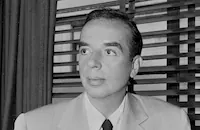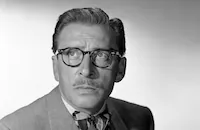On a Clear Day You Can See Forever

Brief Synopsis
Cast & Crew
Vincente Minnelli
Barbra Streisand
Yves Montand
Bob Newhart
Larry Blyden
Simon Oakland
Film Details
Technical Specs

Synopsis
In order to break a smoking habit repugnant to her fiancé, Warren, New Yorker Daisy Gamble attends a class taught by psychiatrist Marc Chabot. Under hypnosis Daisy reads the professor's mind, demonstrates psychic power by making flowers grow rapidly, and reenacts earlier incarnations, including her life in England as Lady Melinda Winifred Waine Tentrees. As Daisy continues her sessions with Marc, her relationship with the rigid Warren deteriorates. For consolation she turns to stepbrother Tad. During a key interview Daisy discloses that in her life as Lady Tentrees she was born the illegitimate daughter of a kitchen maid. In the orphanage where her mother worked she acquired the paternity records of the orphans and subsequently blackmailed their wealthy sires, eventually marrying nobility. Publicity given Marc's research jeopardizes his position, but the psychiatrist is exonerated when the university's patron indicates an interest in extrasensory perception. Arriving early for her appointment, Daisy turns on Marc's tape recorder and hears the doctor lament that, while he is infatuated by Lady Tentrees, he finds Daisy quite limited. Enraged, she storms out of the office, but returns when summoned psychically by the physician. During their final encounter, she describes 14 lives, including her incarnation as Laura and marriage to the psychiatrist in 2038. Following the session, Chabot and Daisy separate. Songs : "Hurry! It's Lovely Up Here!" (Daisy), "On a Clear Day You Can See Forever" (Chorus), "Love With All the Trimmings" (Daisy), "Melinda" (Marc), "Go To Sleep" (Daisy), "He Wasn't You" (Daisy), "What Did I Have That I Don't Have?" (Daisy), "Come Back to Me" (Marc), "On a Clear Day..." (Marc), "On a Clear Day..." (Daisy).

Director

Vincente Minnelli
Cast

Barbra Streisand

Yves Montand

Bob Newhart
Larry Blyden

Simon Oakland

Jack Nicholson
John Richardson

Pamela Brown

Irene Handl
Roy Kinnear
Peter Crowcroft
Byron Webster

Mabel Albertson

Laurie Main
Kermit Murdock
Elaine Giftos
John Le Mesurier
Angela Pringle

Leon Ames
Paul Camen
George Neise
Tony Colti
Crew
Gene Anderson Jr.
John A. Anderson
Cecil Beaton
David Bretherton
Raphael Bretton
John De Cuir
Wayne Fitzgerald
Frederick Glaser
George James Hopkins
Howard Jeffrey
Walter Kelley
Molly Kent-wade
Howard W. Koch
Howard W. Koch
Burton Lane
Alan Jay Lerner
Alan Jay Lerner
Alan Jay Lerner
Joseph J. Lilley
William Mcgarry
John Ott
Sergei Petschnikoff
William R. Poole
Harry Ray
Nelson Riddle
Howard Roessel
Elden Ruberg
Arnold Scassi
Harry Stradling
Shirlee Strahm
Tyler Camera Systems
Universal Title
Betty Walberg
Flo Williamson
Ben Winkler

Videos
Movie Clip
Hosted Intro
Film Details
Technical Specs

Articles
On a Clear Day You Can See Forever
Paramount purchased the film rights in April 1966 for $750,000, and Lerner (who wrote the screenplay) teamed up with Howard W. Koch to form a production company with Koch as producer. While Lerner and Lane liked Barbara Harris' performance in the play, Howard Koch could not risk a multi-million dollar production on an actress who wasn't a big box office name. Instead, Koch wanted to cast Audrey Hepburn for the leading role of Daisy Gamble but she passed on the part. He then went to Barbra Streisand, who he had seen on Broadway in Funny Girl and thought "stunning." Since Streisand had already been signed to make the film version of Funny Girl (1968), Koch felt that she would be a safe bet. However, the actress, then appearing in Funny Girl in London, turned him down because she was pregnant. While he tried half-heartedly to find a replacement, Koch couldn't let go of the idea of Streisand. Not needing a firm commitment from her or any other star until the end of 1966, Koch waited it out. The producer tried again when Streisand returned home to New York shortly before the birth of her son, Jason Gould. This time, he offered her $350,000 (a big increase from her Funny Girl salary) and the ability to choose her director and her co-star. Streisand agreed, later explaining that she wanted to play the role because "the two parts in Clear Day come close to my own schizophrenic personality. The frightened girl as compared to the strong woman in me. Just heaven!" There was one catch - Streisand would not be available until she gave birth, and then filmed Funny Girl and Hello, Dolly! (1969). Koch and Lerner would wait.
On a Clear Day You Can See Forever was very loosely based on both John L. Balderson's 1929 play Berkeley Square and the famous "Bridey Murphy" case in which a 1950s Colorado housewife supposedly recalled minute details of a previous life in 1800s Ireland while under hypnosis. In the film, Daisy Gamble is a modern-day New Yorker who attends a class by psychiatrist Dr. Marc Chabot (Yves Montand). Under hypnosis, Daisy shows definite psychic abilities, and Chabot is intrigued. When Daisy's fiancé, Warren (Larry Blyden) asks her to stop chain-smoking, she turns to Chabot for help. In a hypnotic trance, Daisy reveals her past life as the elegant and sexy English courtesan Melinda Tentrees, who lived in the early 1800s. Chabot finds himself becoming infatuated with the long-dead Melinda, while completely unimpressed with Daisy. Also in the cast were Jack Nicholson, Bob Newhart, Mabel Albertson, Roy Kinnear, Simon Oakland, and Pamela Brown.
Despite the fact that the popularity of film musicals was in decline by the late 1960s, On a Clear Day You Can See Forever was a top-notch production at Paramount. Nelson Riddle, famous for working with Frank Sinatra, was in charge of music supervision, which included arranging and conducting the score. Although some songs were cut from the original production, the film's soundtrack would include the future standards What Did I Have That I Don't Have (a hit for Eydie Gormé) and the title track. Streisand modern-day clothes were created by her own personal choice, Arnold Scassi (who had dressed stars like Joan Crawford and Natalie Wood, but had never designed for film), and while the period costumes were done by Cecil Beaton, who had created Audrey Hepburn's gowns for My Fair Lady (1964).
Getting a co-star proved difficult. British actor Richard Harris kept them waiting for weeks before turning the role down, as did Frank Sinatra, Gregory Peck, and Louis Jourdan. Although Jourdan refused, he left the producers intrigued with the idea of having a "sexy Frenchman" in the role, and they approached French actor-singer Yves Montand, whose acceptance of the role necessitated a name change for the character from Dr. Bruckner to Dr. Chabot. To be convincing as an Englishwoman in her scenes as Melinda, Streisand hired actress Deborah Kerr to help her get her accent down pat.
Production began in January 1969 at Paramount Studios, with location shooting at the Rose Garden in Exposition Park in downtown Los Angeles, various sites in New York City, including the Pan Am Building and Central Park, and locations in the seaside resort of Brighton, England, including the famous Royal Pavilion. On a Clear Day You Can See Forever required eight weeks rehearsal and pre-recording of the musical numbers at the Samuel Goldwyn Studios which would be lip-synced later on screen. All of these elements and delays made the budget soar to $10 million, an enormous sum for the late 1960s.
On a Clear Day You Can See Forever opened at the Loew's State I theater in New York City on June 17, 1970, where it received mixed reviews from critics like The New York Times' Vincent Canby, who wrote that it was "quite ordinary and Broadway-bland in most of its contemporary sequences," but that "Minnelli's love of décor transforms the movie into very real fantasy, and the star into a stunning looking and funny character who mouths her arch, pseudo-Terence Rattigan lines as if she were parodying Margaret Leighton. [...] It's apparently Montand's fate to be emasculated by big Hollywood actresses, and his role is largely that of a line-carrier for Streisand. He behaves himself like a gentleman, however, as do some other decent performers, including Bob Newhart, Larry Blyden, and Jack Nicholson." Canby had no doubt that Streisand's career would survive a mediocre film, writing that "Talent such as hers will not break when tested; it becomes enriched." On a Clear Day You Can See Forever would go on to make $14 million at the US box office, and Barbra Streisand would go to both star and direct films for the next four decades.
SOURCES:
http://www.afi.com/members/catalog/DetailView.aspx?s=&Movie=23487
http://www.boxofficemojo.com/movies/?id=onacleardayyoucanseeforever.htm
Canby, Vincent "Screen: On a Clear Day You Can See Forever Begins Its Run" New York Times 18Jun 70
The Internet Movie Database
Nickens, Christopher and Swenson, Karen The Films of Barbra Streisand
"Please Don't Pick on Daisy" TIME 29 Oct 65
By Lorraine LoBianco

On a Clear Day You Can See Forever
Quotes
Have you ever been to England, Miss Gamble?- Dr. Marc Chabot
No, I'm afraid of flying. Well, not so much of flying, more so of the "no smoking" sign!- Daisy Gamble
Answers make you wise, questions make you human.- Dr. Marc Chabot
Could anyone among us, have an inkling or a clue...what magic feats of wizardry and voodoo you can do?- Dr. Marc Chabot
Trivia
Most of Jack Nicholson's role was left on the cutting room floor.
Notes
Location scenes filmed in New York City and at the Royal Pavilion in Brighton, England.

Miscellaneous Notes
Released in United States Winter January 1, 1970
Released in United States June 1970
Released in United States Winter January 1, 1970
Released in United States June 1970















